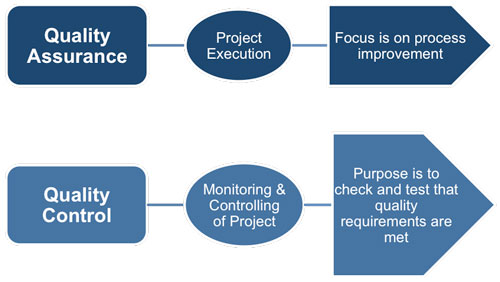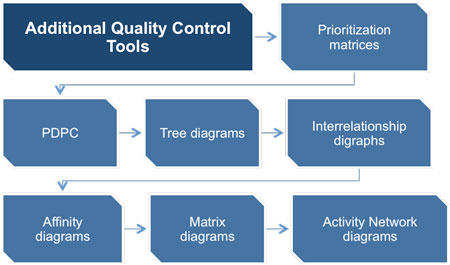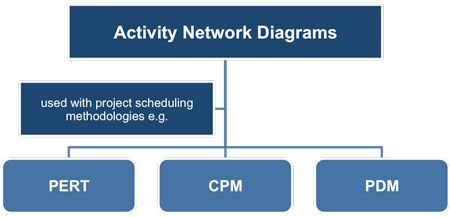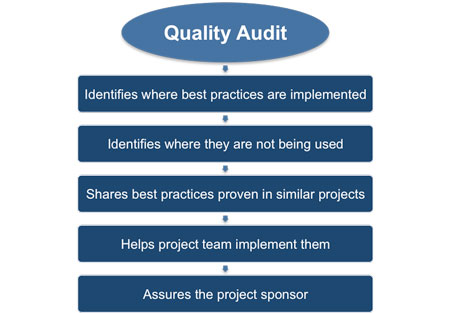Project Quality Assurance
There is a lot of confusion about quality assurance and quality control. The difference is that quality assurance is part of the executing process and is concerned with making sure that the quality objectives are met. It is focused on process improvement.
 |
Quality control, on the other hand, is part of the monitoring and controlling process and is concerned with checking (by means of measuring and testing) that the quality requirements are being met. This process also provides an umbrella for continuous process improvement, which is an iterative means for improving the quality of all processes so as to reduce waste and eliminate activities that do not add value.
Quality management tools and quality audits can be used to perform quality assurance. Quality management tools include:
 |
Affinity diagrams
The affinity diagram is similar to mind-mapping techniques in that they are used to generate ideas that can be linked to form organized patterns of thought about a problem. Using the affinity diagram to give structure to the decomposition of scope may enhance the creation of the work breakdown structure (WBS).
Process decision program charts (PDPC)
These charts are used to understand a goal in relation to the steps for getting to the goal. The PDPC is useful as a method for contingency planning because it aids teams in anticipating intermediate steps that could derail achievement of the goal.
Interrelationship digraphs
The interrelationship digraphs provide a process for creative problem solving in moderately complex scenarios that possess intertwined logical relationships for up to 50 relevant items. The interrelationship digraph may be developed from data generated in other tools such as the affinity diagram, the tree diagram, or the fishbone diagram.
Tree diagrams
Tree or systematic diagrams may be used to represent decomposition hierarchies such as the:
• WBS (work breakdown structure),
• RBS (risk breakdown structure), &
• OBS (organizational breakdown structure).
In project management, tree diagrams are useful in visualizing the parent-to-child relationships in any decomposition hierarchy that uses a systematic set of rules that define a nesting relationship. Tree diagrams can be depicted horizontally (such as a risk breakdown structure) or vertically (such as a team hierarchy or organizational breakdown structure OBS). Because tree diagrams permit the creation of nested branches that terminate into a single decision point, they are useful as decision trees for establishing an expected value for a limited number of dependent relationships that have been diagramed systematically.
Prioritization matrices
These are used to identify the key issues and the suitable alternatives to be prioritized as a set of decisions for implementation. Criteria are prioritized and weighted before being applied to all available alternatives to obtain a mathematical score that ranks the options.
Activity network diagrams
In the past activity network diagrams have been known as 'arrow diagrams'. They include both the AOA (Activity on Arrow) and, most commonly used, AON (Activity on Node) formats of a network diagram.
 |
Activity network diagrams are used with project scheduling methodologies such as program evaluation and review technique (PERT), critical path method (CPM), and precedence diagramming method (PDM).
Matrix diagrams
A quality management and control tool used to perform data analysis within the organizational structure created in the matrix. The matrix diagram seeks to show the strength of relationships between factors, causes, and objectives that exist between the rows and columns that form the matrix.
A quality audit consists of structured, independent review to determine whether project activities comply with organizational and project policies, processes, and procedures. The words 'independent' and 'audit' are open to interpretation depending on the requirements of the particular project.
 |
There is no need to use external auditors or to make the process particularly formal or bureaucratic provided that the information fed back from the process is credible to both the project team (who are doing the work) and the sponsor (who is paying for it). The audit should:
1) Identify where the best practices being implemented
2) Identify where they are not being used
3) Share best practices proven in similar projects
4) Help the project team to implement them
5) Assure the project sponsor that work is being done in line with accepted best practices
This process should result in a reduced cost of quality and an increase in sponsor or customer acceptance of the project's product. Quality audits can be carried out whenever necessary for either the whole project or a part of it.
You may also be interested in:
Managing Project Quality | Quality Management Techniques | Project Quality Management and ISO Quality Management | Quality Assurance | Quality Control | Testing Project Deliverables | Quality Audits | Post-Implementation Audits.
|
|


